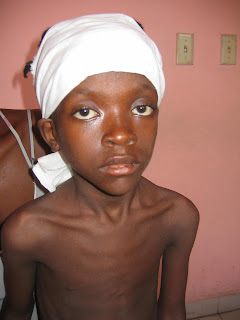Structural Violence
Sunday, December 03, 2006
Structural Violence
 I remember the first time I read about “structural violence” regarding the poor in developing countries. I did not understand what the author was writing about. Medical students don’t take courses in structural violence. We may know about the Sylvian fissure, the coronary sinus, and oncotic pressures, but structural violence was definitely not mentioned in my training. Until I came to Haiti.
I remember the first time I read about “structural violence” regarding the poor in developing countries. I did not understand what the author was writing about. Medical students don’t take courses in structural violence. We may know about the Sylvian fissure, the coronary sinus, and oncotic pressures, but structural violence was definitely not mentioned in my training. Until I came to Haiti.Farmer, Nizeye, Stulac, and Keshavhee wrote a great paper called “Structural Violence and Clinical Medicine”. The bottom line is that until doctors understand structural violence and do something to change it, all of the molecular biology and genetics in the world will not significantly help the world’s poor.
The authors define structural violence as…” social structures—economic, political, legal, religious, and cultural—that stop individuals, groups, and societies from reaching their full potential. In its general usage, the word violence often conveys a physical image; however, according to Galtung it is the “avoidable impairment of fundamental human needs or…the impairment of human life, which lowers the actual degree to which someone is able to meet their needs below that which would otherwise be possible.”
Structural violence is often embedded in long-standing “ubiquitous social structures, normalized by stable institutions and regular experience.” Because they seem so ordinary in our ways of understanding the world, they appear almost invisible. Disparate access to resources, political power, education, health care, and legal standing are just a few examples. The idea of structural violence is linked very closely to social injustice and the social machinery of oppression”.
Farmer goes on to say that, “With few exceptions, clinicians are not trained to understand such social forces, nor are we trained to alter them. Yet it has long been clear that many medical and public health interventions will fail if we are unable to understand the social determinants of disease.”
Anyone with a grade school education should be able to understand this. Structural violence as a concept is not hard to understand. But it is a scary concept for some to accept.
The child pictured at the top has very aggressive tuberculosis which is a disease of poverty. The social structures in the world did not allow this child to “reach his full potential”, i.e. good health. This child definitely had “disparate access to resources…”
The picture at the bottom is a photo of a crushed empty bottle of Pedialyte lying in a puddle of sewage on a major street in Port-au-Prince.
Thanks to Haiti, even I can understand the danger and damage and death created by “structural violence” in the world.


Comments
Post a Comment